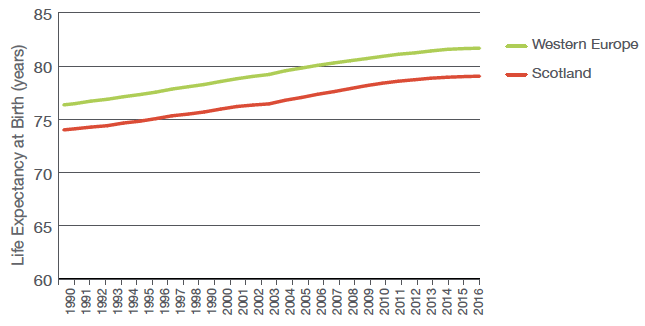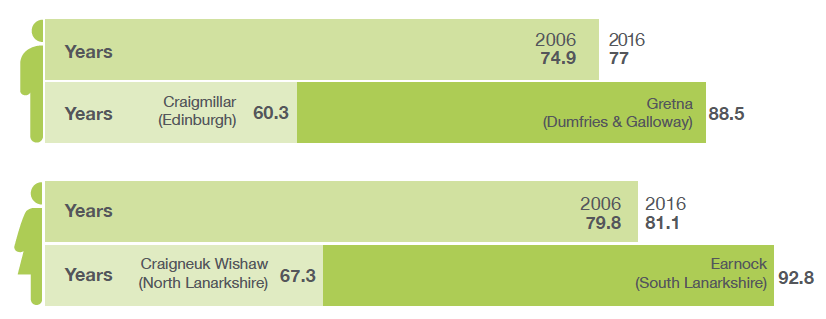Scotland's public health priorities
Report on Scotland's six public health priorities.
02 Why we need change: Scotland’s Health
Over the last century our health has improved. There have been long term increases in average life expectancy in Scotland and we have seen considerable improvements in the overall health of the population. In Scotland, and in other countries, this progress is a result of public health efforts including action to tackle infectious disease and initiatives to provide clean water and sanitation. The provision of high quality healthcare to those who need it has also helped improve the health of the population.
In 2018, the average life expectancy at birth across Scotland was 81 years for females and 77 years for males. People are now living longer than ever before, and that is a huge success.
Despite this tremendous progress, Scotland now has one of the lowest life expectancies in Western Europe and the lowest of all UK countries. This was not always the case – in the earlier half of the 20th century Scotland’s life expectancy was well aligned with others in Europe. (Figure 1 below).
While life expectancy is increasing overall, there are significant differences in the life expectancy and health of people across Scotland, depending on factors such as where they live, their age and gender, and their ethnic group. People living in less affluent areas of Scotland have a shorter life expectancy than those living in wealthier areas. (Figure 2 opposite).
Healthy life expectancy – the number of years we can expect to live in good health – also varies significantly across Scotland. At the population level, there are marked differences between the most and least deprived areas in terms of how long people can expect to live in good health. This can be a difference of up to 28 years for men and 25 years for women.
These differences are strongly influenced by the social conditions in Scotland, the circumstances into which people are born, the places where they live, their education, the work they undertake, and the extent to which good social networks exist.
The impact of these variations in health within Scotland, at the same time as the population is ageing, is wide-reaching. More people in Scotland are now living with one or more complex health conditions. They require more health and social care and that requirement will increase as they age. Fewer people are able to work and remain in work as a result of health problems or because of the requirement to care for loved-ones who are unwell.
There are human costs in terms of life expectancy and years lived in poor health, but this also limits our ambition to build a thriving and prosperous Scotland where our people achieve their full potential. For our public services, responding effectively to this burden of poor health and inequality will become unsustainable.
None of this is acceptable. Despite tremendous progress in life expectancy it is not acceptable that our health is poorer than other parts of Europe, and it is not acceptable that people in Scotland are not able to thrive.
The time for change, for a transformation in our efforts, is now.
Figure 1: Life Expectancy in Scotland (red line) and other Western European countries

Source: Institute for Health Metrics and Evaluation ( IHME). Life Expectancy & Probability of Death Data Visualization. Seattle, WA: IHME, University of Washington, 2016. Available from http://vizhub.healthdata.org/le/. (Accessed June 2018)
Figure 2: Life Expectancy in Scotland, 2006 – 2016; and comparing affluent and less affluent areas

Source: Scottish Public Health Observatory http://www.scotpho.org.uk/population-dynamics/healthy-life-expectancy/data/scotland/ (Accessed June 2018)
Contact
There is a problem
Thanks for your feedback